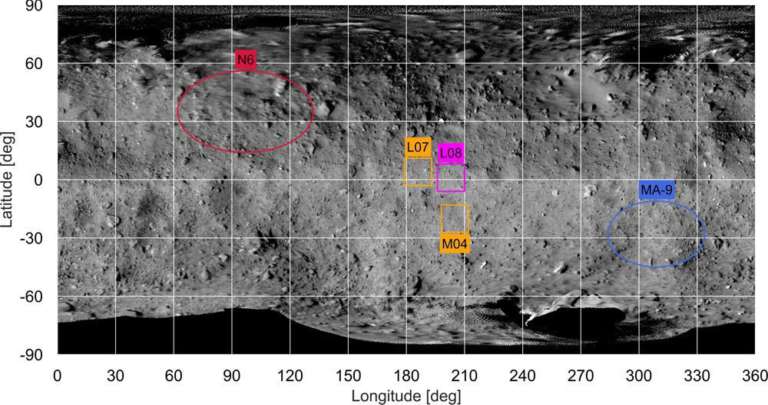Emily Lakdawalla • Aug 24, 2018
Hayabusa2 Team Announces Ryugu Landing Sites, Initial Science Survey Results
It's been two months since Hayabusa2 arrived at Ryugu, and the team reported some preliminary facts (PDF) about the asteroid at a press briefing held yesterday. They also announced the selection of candidate landing sites for the spacecraft sample collection, for the German-built MASCOT hopper, and for the MINERVA-II microrovers.
Ryugu Facts
- Ryugu has a top shape with a very circular equatorial bulge. This kind of shape is predicted for fast-rotating asteroids, but had not been predicted for Ryugu because it rotates relatively slowly.
- Speaking of which, Ryugu's day length has been measured at 7.63 hours.
- Its mean diameter is about 900 meters. Its equatorial diameter is about 1000 meters, and its polar diameter about 880 meters.
- It has a mass of 450 million tons, giving it a density of about 1200 kilograms per cubic meter. If it's mostly rock (which has a density of around 3000 kilograms per cubic meter), then it's pretty porous.
- Its reflectance is 0.02 (very, very dark).
- It has similar crater density to Itokawa and Eros.
- It is covered with boulders, with the largest one near the south pole being 130 meters across. The amount of boulders was unexpected and is "causing some consternation" among the team, according to OSIRIS-REx principal investigator Dante Lauretta, because the boulders present touchdown hazards. (The OSIRIS-REx team works closely together with the Hayabusa2 team, and Lauretta was at the Hayabusa2 landing site selection meeting in Japan.)
- The surface has diverse materials on it, mixed together. This is good news for Hayabusa2's landing, because "regardless of where the sample is collected, there is a high possibility of gathering diversified materials that represent the whole of Ryugu." The mission had been prepared to perform multiple landings to gather diverse materials, but that might not be necessary.
- Surface optical spectra are flat, bluer in the equatorial bulge and at the poles. (Most asteroid have pretty flat spectra, and most are reddened by space weathering; bluer surfaces correspond to fresher surfaces, usually.)
Up, down, north, south
At the press briefing, Hayabusa2 team members clarified an important detail about Ryugu mapping. For small bodies, north is defined using the right-hand rule. Using the right-hand rule, bodies that rotate prograde (in the same direction Earth does, and in the same sense that the planets revolve around the Sun) have their north poles pointing toward ecliptic north. But if a body rotates retrograde, then the body's north pole is defined as the one that points toward ecliptic south. Ryugu is a retrograde rotator. The images that have been posted so far have had south up; the mission is now disciplining itself to post images with north up. The big funky boulder is at Ryugu's south pole.
I particularly appreciated this nerdy point about WHICH north should be at top - Earth's or Ryugu's pic.twitter.com/nEnzifcky7
— Jonathan McDowell (@planet4589) August 24, 2018

Landing Site Selection
The Hayabusa2 team held a landing site selection conference on 17 August 2018, selecting candidate sites for the spacecraft, the German-built MASCOT lander, and the MINERVA-II mini-landers. MINERVA-II will land first, and it was important to select candidate landing sites for MASCOT and Hayabusa2 in order to make sure the more capable spacecraft got first dibs on their preferred locations.
Landing sites for the spacecraft had to be within 200 meters north or south of the equator to ensure adequate spacecraft tracking. Other criteria included restrictions on slope, surface roughness, boulder heights, and temperatures at landing time. The process (described in great detail in the press conference slides) yielded the selection of a primary site and two backup sites.
With the spacecraft landing sites picked, the team moved on to MASCOT. Because the lander will hop once to a second location, they have to select large landing regions. The MASCOT team came up with six potential sites, ranking them in order of priority, most of them in the southern hemisphere.
Finally, the team picked places for the four MINERVA-II microrovers, selecting several possible locations in the northern hemisphere.
Here's a map of the highest-ranked landing sites:

Tricky Landing
Touching down on Ryugu without damaging the spacecraft will be a challenge. Originally the team planned to perform multiple landings in order to sample diverse materials, but it now appears they will focus their efforts on just one spot. They plan to perform at least two landing rehearsals, approaching very close to the asteroid to gather navigational data and high-resolution images. They'll abort if they find it difficult to operate the spacecraft or find a hazardous situation with boulders or slopes. They reserve the right to start over with a different candidate landing site depending on what they learn during the rehearsals.
The future plans are:
- Hayabusa2 is now in a period of "Box B" operations, in which it remains about 20 kilometers above the asteroid but moves in the X and Y directions to survey the asteroid from different points of view. It is planned to return to Home Position on 7 September.
- Next press briefing: 5 September (4 September in the U.S.)
- Touchdown rehearsal 1: 11-12 September
- MINERVA-II landing 1: 20-21 September
- Press briefing: 27 September
- MASCOT landing: 2-4 October
- Touchdown rehearsal 2: mid-October
- Touchdown 1: late October

Support our core enterprises
Your support powers our mission to explore worlds, find life, and defend Earth. You make all the difference when you make a gift. Give today!
Donate

 Explore Worlds
Explore Worlds Find Life
Find Life Defend Earth
Defend Earth


